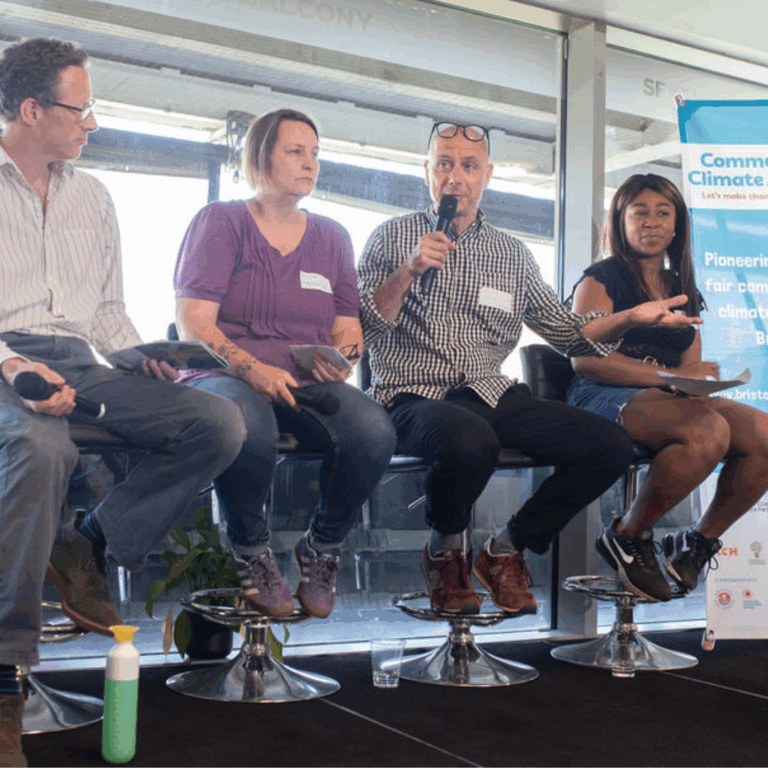How can councils accelerate work on community climate and nature action?
As 2025 draws to a close, it marks five years of the Community Climate & Nature Action Project in Bristol. In this blog, Mark Leach, Climate Engagement Coordinator at Bristol City Council shares insights on the council’s involvement as a core project partner as well as personal highlights from his role.
The Community Climate & Nature Action Project is one of the most rewarding projects I’ve worked on in two decades at the council. Highlights have included peer review events, interest from the national Climate Change Committee, and helping create climate action stories for our community partners. One standout highlight isn’t an event – it’s the co-production itself, brilliantly captured by Suzanne Wilson. But perhaps best of all has been seeing delivery with projects coming to fruition, creating jobs and providing health benefits for the communities involved.
What is community climate and nature action?
The Community Climate & Nature Action Project comprises several strands including co-production of action plans, a community panel looking at policy through a just transition lens, the Climate and Disability project and the creativity and arts strand – all funded by the National Lottery’s Climate Action Fund.
The 17 community action plans set out how communities want to tackle health, jobs and transport and other issues through climate and nature action. In 2019, John Rose from the Big Lottery told Communicate conference the (then embryonic) Climate Action Fund was all about “putting local people in the driving seat” on climate action. Five years on, I think we’ve helped make that vision a reality.
Enabling, unlocking and unblocking
Turning plans into delivery often requires council input. For example, the community in Lockleaze Neighbourhood Trust’s demonstrator project wanted to grow food and pollinator plants on land owned by the council. Anyone who’s worked with land permissions knows how tricky that can be. Step forward Hayley Swift from our Community Development team, whose considerable experience at brokering relationships brought about those conversations, and ultimately the Trust delivering the planting project.
Co-benefits
Because of the Community Climate & Nature Action Project, there are now new social enterprises set up and employing people, thousands of tonnes of waste food being made into compost; ‘green desert’ areas on estates now productively planted; refugees and asylum seekers offered training to help them access the burgeoning low carbon jobs sector – growing three times faster than the rest of the economy; kids have learned about growing and cooking healthier food, and hundreds of households are warmer and have lower bills after learning DIY skills and energy efficiency advice.
Making connections
For the Community Leadership Panel, council input has been critical. As well as providing representation from colleagues working on the Local Plan, Mission Net Zero, and Keep Bristol Cool project, we helped with those relationships for Bristol City Leap, a local NHS Trust and Temple Quarter Enterprise Zone to come and present, too. It’s been great to see the Panel’s input having influence and this is an interesting blueprint to see replicated elsewhere.
Use citywide, strategic perspective to catalyse action…
Terry Black and Mohammed Elsharif head up the council’s two Community Development teams and their support for community-led climate and nature action dates back to well before this project. Along with Mark Pepper at Ambition Lawrence Weston, they gave us the principles we channelled into that very first bid for National Lottery funding – just before the pandemic hit.
… then know when to let go
A partnership organisation like Bristol Climate & Nature Partnership has been critical to the success of the programme. Whilst the council was able to use our strategic knowledge of the city to spot the ‘gap’, the Partnership leading on the programme has helped build and broaden trust and ownership, allowed for more flexibility and responsiveness and helped with the visibility and profile of the programme. It’s no exaggeration to say we couldn’t have done it without them.
Funding for delivery
The programme has also helped community groups bring in further funding – through grants and income generation. I’m also delighted with the £100,000s secured from external funders by council colleagues to go direct to community-led action, with even more to help delivery. It’s because council managers have understood the value of the Community Climate & Nature Action Model that they have built its progression into funding bids.
Maintaining political support
Managers “getting” the benefits has another significant impact. There is another group of people without whom none of this would have happened, and that’s our elected city leaders. Councillors ultimately make the decisions on what we officers work on. And that requires briefings and reporting which are convincing. Successive administrations of different political colours can be credited with seeing the benefits of this approach to people across the city.
A legacy of learning
Projects like this also leave a legacy within the council. Working with over 30 colleagues from the 17 community partners has been a constant source of hope and inspiration.
Emma Geen’s work on Climate and Disability has been a gamechanger for me. She and Amy Harrison have crystallised the importance of joy, fun and creative expression in working with communities. I hope I live up to their example by continuing that approach.
If you’re part of a council or community group and want to explore this approach, we’d love to hear from you contact@bristolclimatenature.org – want to book a meeting? Let’s talk climate and nature action in your community.
Find out more about the Community Climate & Nature Action Project
Share to
